Class 6 Exam > Class 6 Notes > Class 6 All Subjects (Old NCERT) > NCERT Summary: In the Earliest Cities
In the Earliest Cities Summary Class 6 Social Science Chapter 3
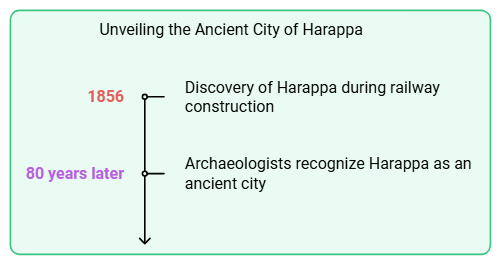
The story of Harappa
- Harappa is in modern day Pakistan.
- This site was accidentally discovered when the East India Company was doing the construction of railway lines in 1856.
- Initially, the construction workers thought the ruins to be of some ordinary old city. The bricks from the site were used for the construction.
- It was about 80 years ago that archaeologists could realize that it was an ancient city.
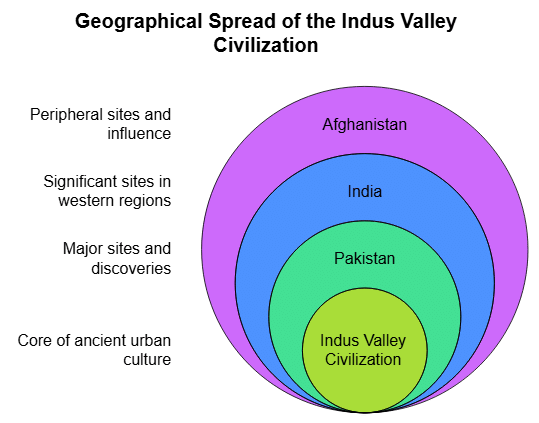
What was special about these cities?
- Mohenjo–Daro, Kalibangan, Lothal and Dholavira are some other important sites of the Indus Valley Civilization. About 150 sites of this civilization have been discovered till date.
- Most of the sites this civilization are in modern day Pakistan. Some of the sites are in India, e.g. Kalibangan (Northern Rajasthan), Banavali (Haryana), Dholavira (Gujarat) and Lothal (Gujarat).
- After excavations from different sites, it has become clear that this civilization was spread over major parts of western India and Pakistan and some parts of Afghanistan.
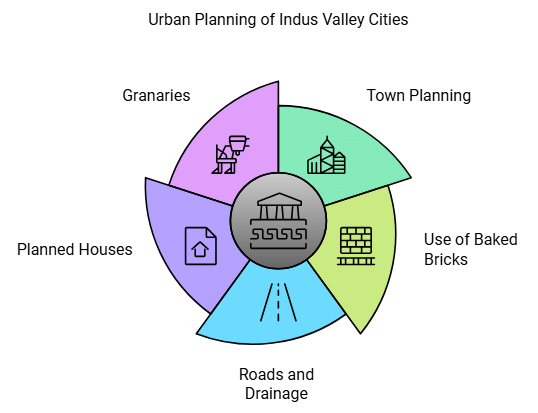
Special Features of these Cities
Town Planning
- These cities show immaculate town planning.
- The city of Harappa was divided into two parts, i.e. western and eastern parts.
- A huge tank has been found within the citadel. This has been named as the Great Bath by archaeologists. This was made from baked bricks.
- Rich people lived in the upper part of the city.
- Workers lived in the lower part of the city.
Use of Baked Bricks
- Houses and other structures were made of baked bricks.
- Bricks were of uniform size which means that the people of Harappa had developed good workmanship.
Roads and Drainage
- Roads were paved with bricks.
- The drainage system was properly planned. Drain from each house was connected to the drains in the streets.
Planned Houses
- The walls of the houses were strong and thick.
- Some of the houses were two storey high which shows the well-developed architecture in those days.
Granaries
- In the cities of the Indus Valley Civilization; a large granary has been found. Charred grains have been found in these granaries which shows that food grain production was surplus during this period.
- Historians also guess that taxes were collected in the form of grains.
- Grains collected as tax were stored in such large granaries.
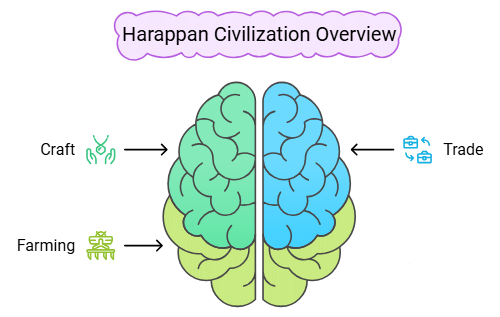
Life of the People
- Some of the possible occupations which may have existed in these cities are:
Craft
- Clay, copper and bronze was used for making pots. Tools, weapons and seals were made from copper and bronze. Seals were also made from clay. Some large pots have also been found. They were probably used for storing grains.
- Jewelleries were made of gold, beads, wood and clay. Precious stones; like cannelian, jasper, crystal, etc. were used to make beads.
- Clay and wood was used for making toys.
- Ornate carvings can be seen on toys, pots and jewellery.
Trade
- Trade was the main occupation of people of Harappa.
- Copper came from Rajasthan and from Oman. Some of the seals from Harappa have been found in Mesopotamia which shows that trade link existed between Harappa and Mesopotamia.
- A dockyard has been discovered in Lothal in Gujarat which shows that trade through sea route existed at that time.
Farming
- Remains of charred grains have been found which shows that wheat, barley, pulses, pea, rice, sesame, linseed and mustard was grown in the villages of the Harappa Civilization.
- A toy model of plough has been found from the ruins which show that plough was used for tilling the land.
- Bones of many domesticated animals have been found from the excavation site which shows that people of Harappa domesticated cattle, sheep, goat, buffalo and pig.
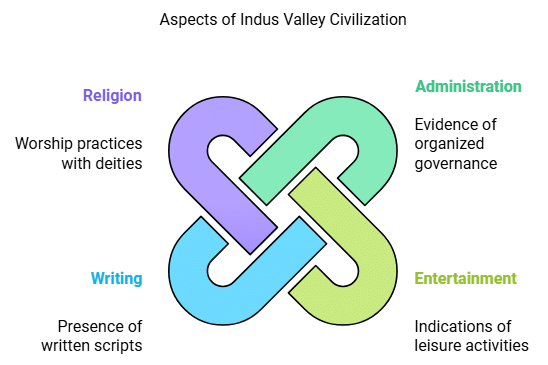
Some Other Aspects of Life
- Historians guess that the city of the Indus Valley Civilization was having some form of administration. There is a possibility of a committee of people to look after the administration.
- People used some form of entertainment. This is evident from toys and statues found from the site.
- Seals from the Harappa site show scripts on them. This shows that people of the city knew how to write.
- People worshipped gods and goddesses. Many statues have been found. This figure is similar to the Hindu god Lord Shiva.

Mystery over Decline of Harappa Civilization
- The Harappa Civilization suddenly declined around 3900 years ago. Broken roads and clogged drains indicate towards a decline in infrastructure.
- Historians have not yet identified the proper cause of the decline of the Indus Valley Civilization. Some guesses have been made which are as follows:
- There is a possibility that the rivers dried up. It forced people to move to some other places.
- There were too many brick kilns and furnaces. It may have damaged the environment. This would have led to deforestation. Lack of green cover may have forced people to move to some other places.
- Overgrazing by cattle and sheep may also have resulted in loss of forests. This would have led to desertification, i.e. formation of desert.
- There is also a possibility of large scale epidemic or natural calamity. It could have wiped off a major portion of the population.
The document In the Earliest Cities Summary Class 6 Social Science Chapter 3 is a part of the Class 6 Course Class 6 All Subjects (Old NCERT).
All you need of Class 6 at this link: Class 6
|
297 videos|1066 docs|204 tests
|
FAQs on In the Earliest Cities Summary Class 6 Social Science Chapter 3
| 1. What is Harappa and why is it significant? |  |
Ans. Harappa was one of the earliest cities of the Indus Valley Civilization. It is significant because it provides valuable insights into the urban planning, architecture, and lifestyle of the people who lived during that time. The ruins of Harappa reveal a highly organized city with well-laid out streets, advanced drainage systems, and sophisticated buildings.
| 2. How did the people of Harappa sustain their livelihood? |  |
Ans. The people of Harappa were primarily engaged in agriculture. They cultivated crops such as wheat, barley, peas, and sesame. The fertile soil of the Indus Valley provided them with abundant resources for farming. They also engaged in trade and commerce, as evident from the discovery of seals and artifacts from other regions.
| 3. What evidence suggests that Harappa had a well-developed trade network? |  |
Ans. The discovery of seals and artifacts from Harappa in various regions suggests that the city had a well-developed trade network. These seals were made of materials like stone, terracotta, and faience, and bore inscriptions in a script that is yet to be deciphered. The presence of these seals in distant places indicates that Harappa was involved in long-distance trade.
| 4. How did the people of Harappa manage their waste and sanitation? |  |
Ans. The people of Harappa had a sophisticated drainage system to manage their waste and sanitation. The city had a well-planned network of drains and covered sewage systems. Each house had its own private bathroom and a covered drainage system connected to the main drain. This advanced system indicates a high level of urban planning and sanitation practices.
| 5. What happened to the civilization of Harappa? |  |
Ans. The civilization of Harappa, along with other cities of the Indus Valley, declined around 1900 BCE. The exact reasons for its decline are still debated among scholars. Some theories suggest natural disasters like floods or earthquakes, while others propose changes in climate patterns or shifts in river courses. The decline of trade and the spread of Aryan culture are also considered possible factors. However, the precise cause of the civilization's decline remains uncertain.
Related Searches

















